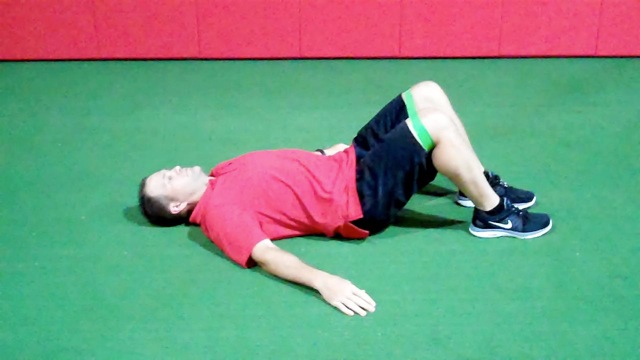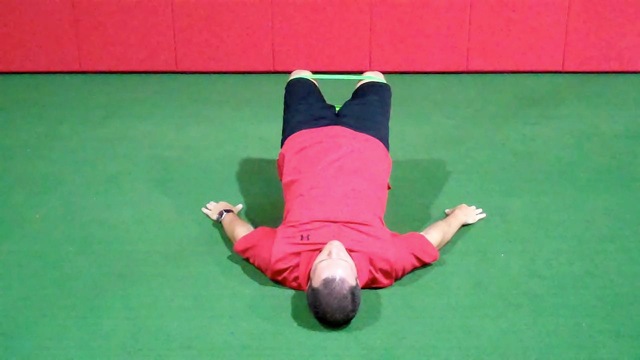
To address weakness in the posterior chain and activate the hip external rotators, I like to utilize a double leg bridge using a mini-band.
Execution:
Place a small mini-band around the distal thighs just above the knee. There should be reasonable tension when the knees are spread evenly apart with the hips in neutral rotation. Prior to bridging, cue the client to tighten the abdominal and pelvic floor muscles.
Next, press down through the heels and lift the hips into full extension achieving a table top position. Be sure to avoid adduction/internal rotation by maintaining resistance against the mini-band throughout. Pause at the top for 2 seconds, and then slowly lower down to the start position lightly touching the floor and repeat. The core activation (isometric hold) should be maintained throughout. Perform 1-3 sets of 10-15 repetitions. A cadence of 1/2/1 or 1/2/2 works well.
 |  |
Allow the client to fully relax the core and re-set muscle tone for each repetition as they rest after each rep on the floor.
Progression:
Do not allow the client to return or contact the floor after the initial repetition throughout the set. The hips should hover just above the floor at the bottom.
 |  |
Application:
This is an excellent exercise to address core and pelvic weakness. The ability to control and resist pelvic drop and undesirable hip internal rotation should be a training goal for clients and athletes affected by knee dysfunction encountered with ankle instability and/or hip weakness with poor core/pelvic stability. Specifically, I utilize this exercise for clients struggling with patellofemoral pain, IT band syndrome, knee/hip overuse symptoms, ACL prehab/rehab, and patellar malalignment and maltracking.
This bridging exercise is also effective in hip and low back training. Using the band to pull the knees/hips into a dysfunctional pattern will act as a tactile cue to encourage proper neuromuscular activation proximally, reinforcing optimal alignment. Adjust the resistance of the band accordingly based on client feedback and execution of proper form.
Additional notes:
Consider isometric holds in the top position, higher resistance and even adding perturbations to further challenge proprioception and train the motor activation pattern when the client is able to progress even further.
Brian Schiff, PT, OCS, CSCS, is a licensed physical therapist, respected author and fitness professional. Currently, he serves as the supervisor at the Athletic Performance Center in Raleigh, NC. Brian presents nationally at several professional conferences and seminars on injury prevention, rehab and sport-specific training. For more cutting edge training information, subscribe to his monthly Training & Sports Medicine Update at www.BrianSchiff.com.















